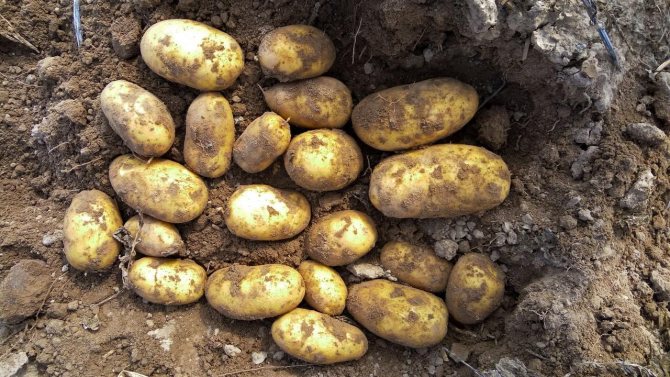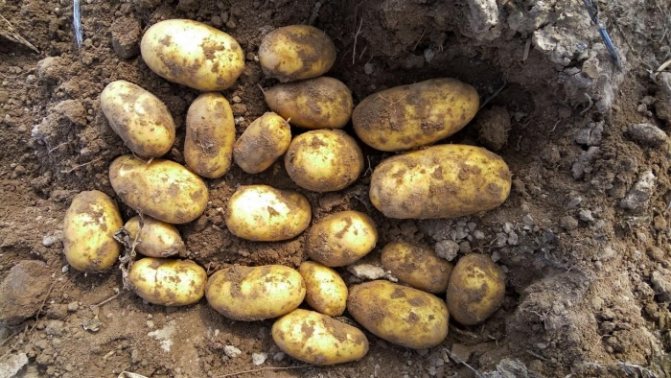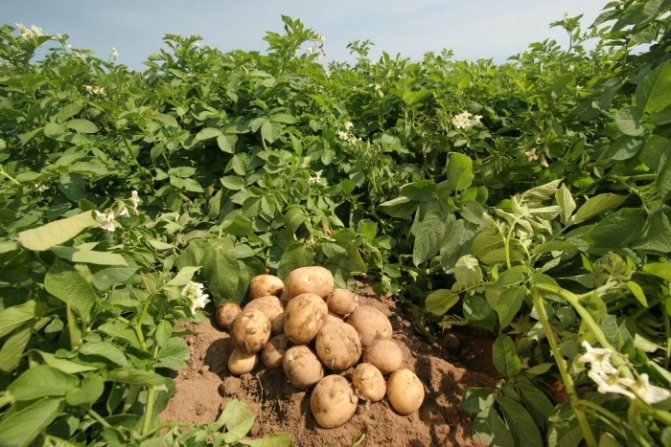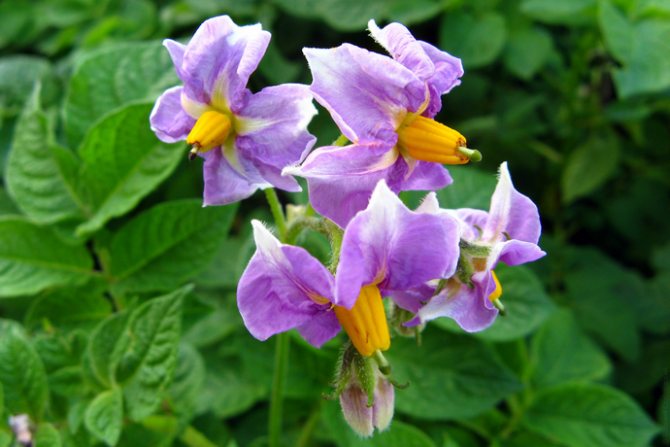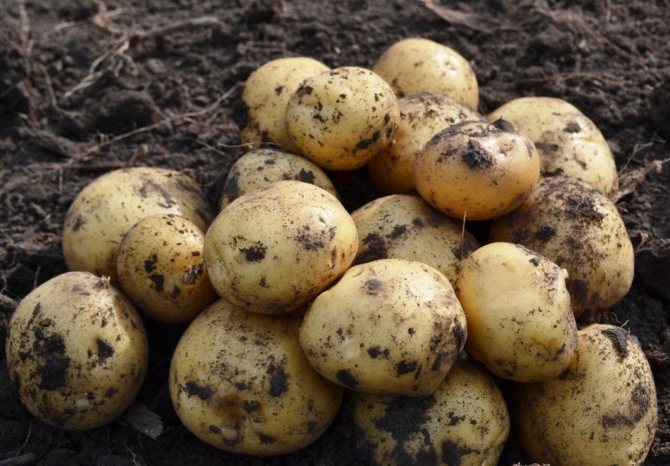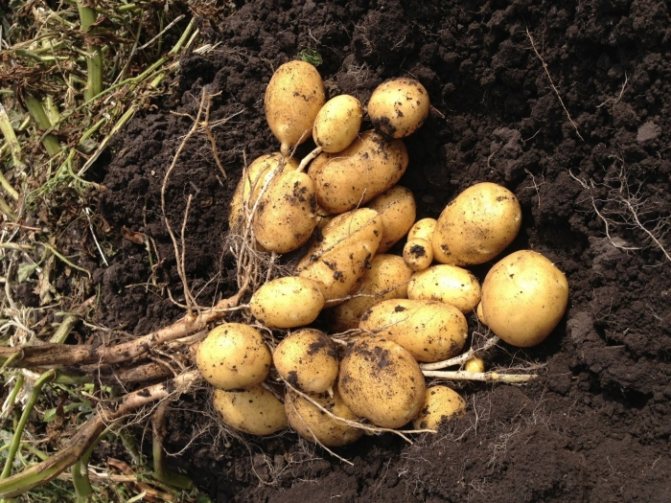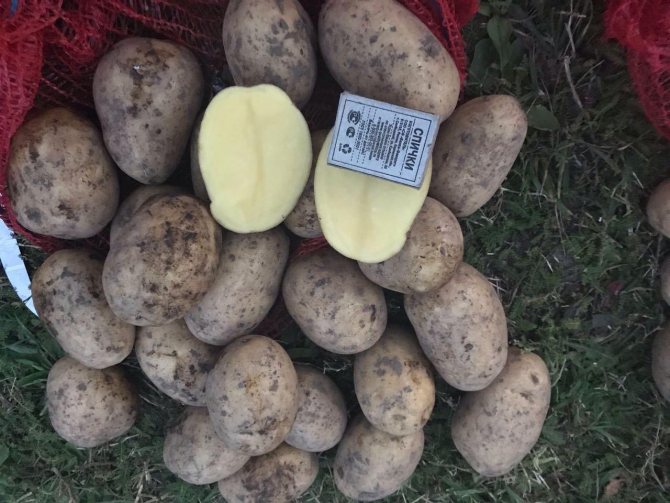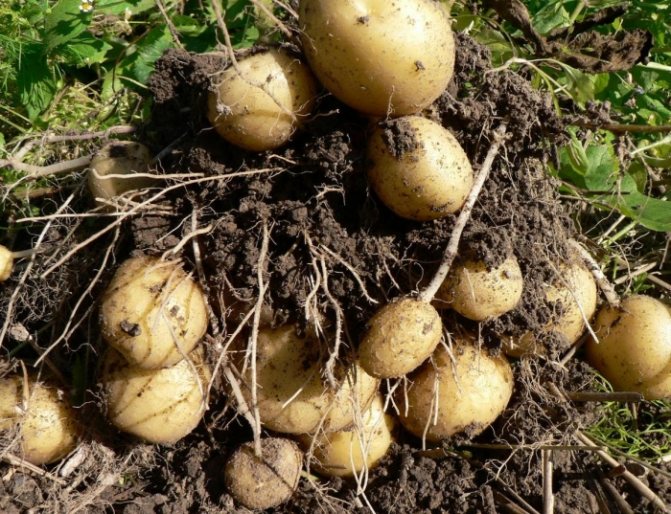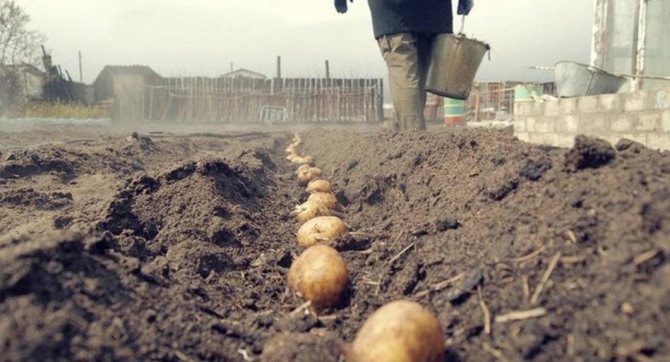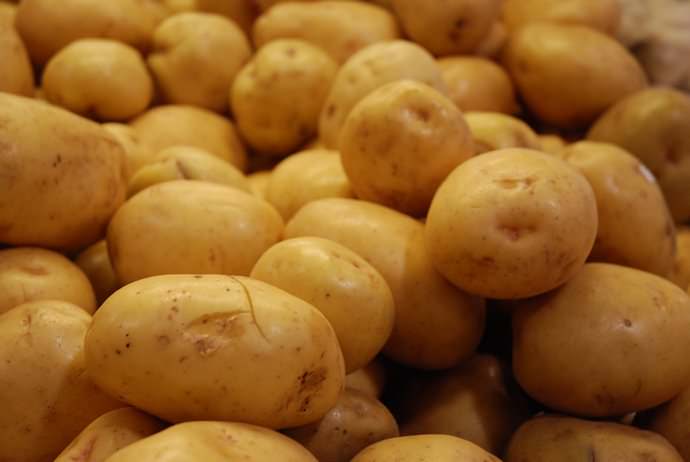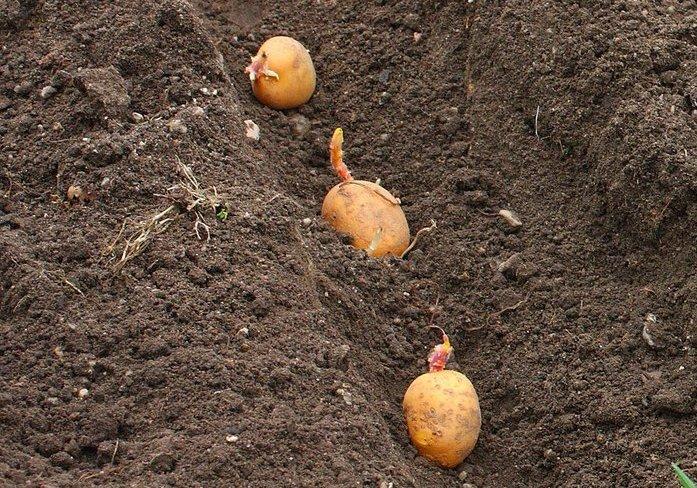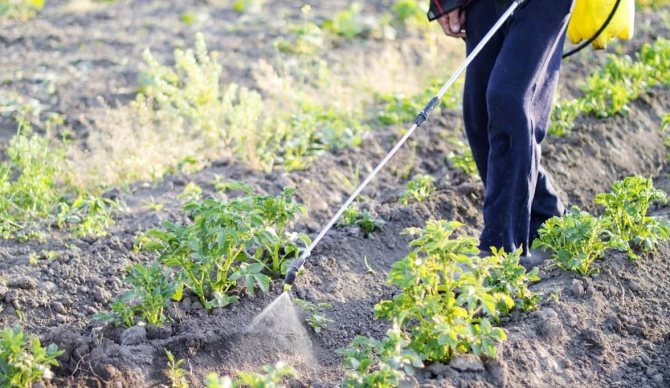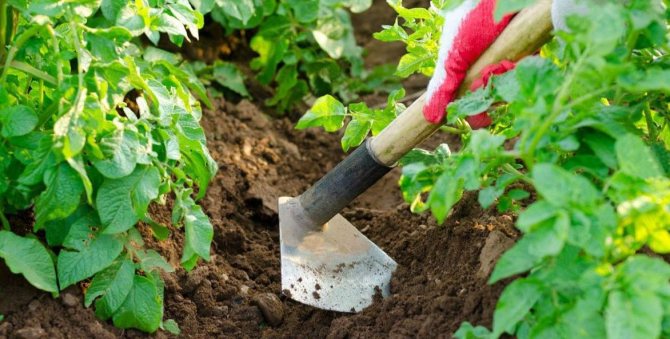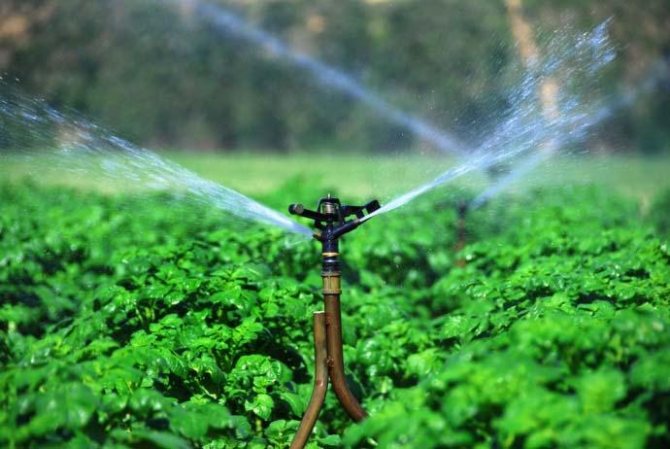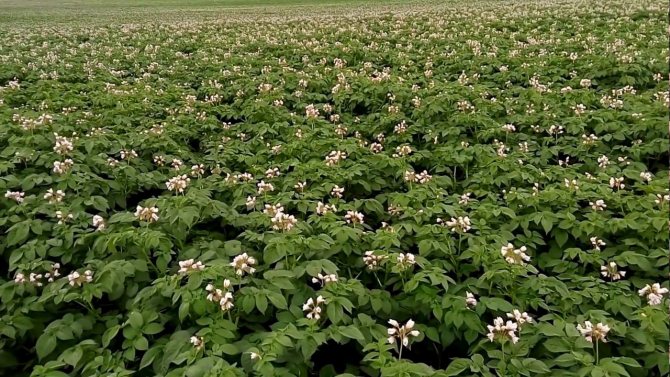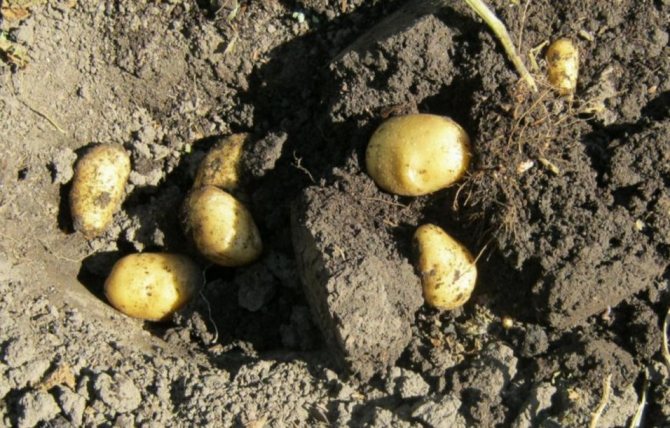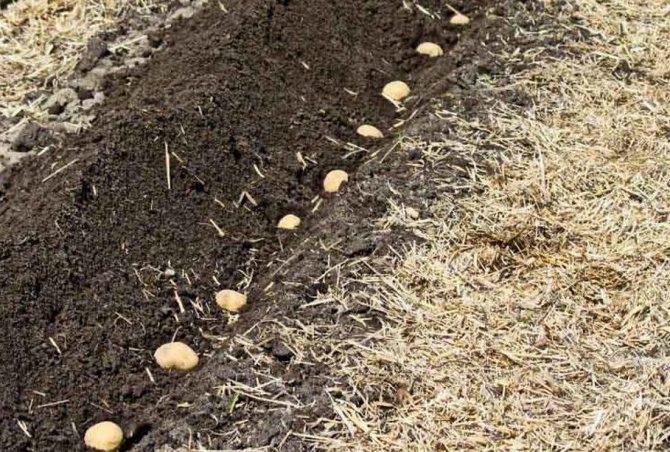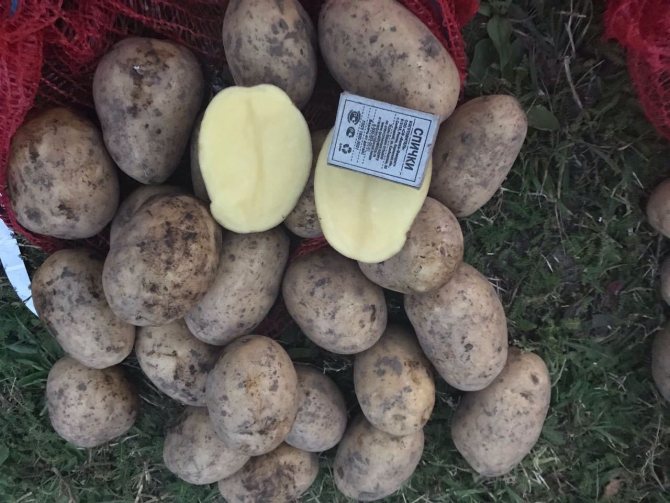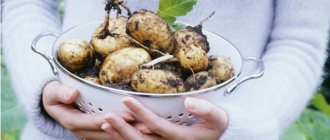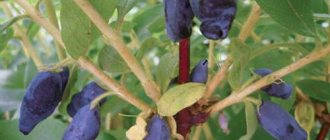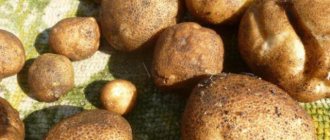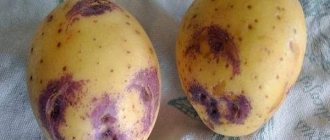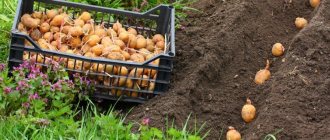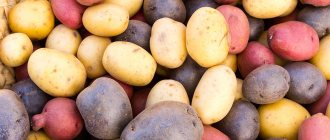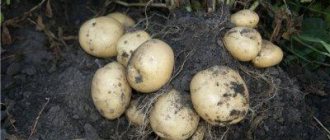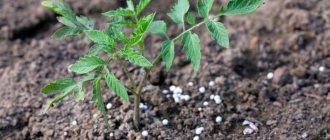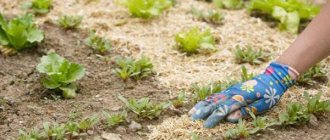Many farmers know that growing early potatoes can maximize profits with a minimum investment. However, to ensure that the farmer's expectations are not turned into disappointment, it is necessary to select the right variety. Juvel is often mentioned when describing the most productive vegetables. The article provides an overview of the culture with the pros, cons, disembarkation and care rules.
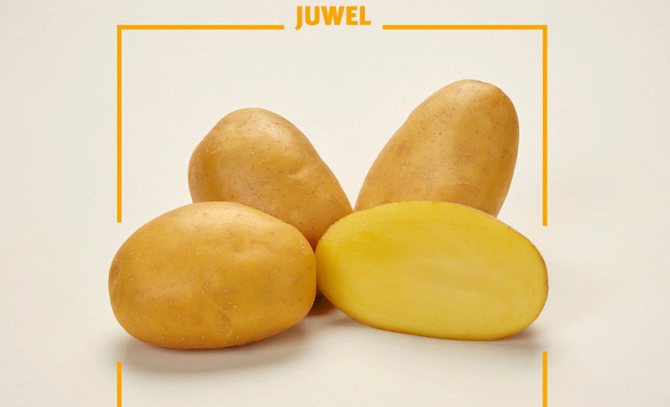
Breeding history
Juvel Potato is a product - Germany. This variety is positioned as universal, it is actively grown not only in private farms, but also on an industrial scale. Juvel potatoes are intended for cultivation in areas with a temperate and continental climate.
Despite the fact that the variety is still not listed in the State Register of Russia, it is still very popular among plant growing enthusiasts.
Juvel Renata Bettini is the full name of a potato.
Description of the variety and characteristics
To always stay with the harvest, you need to familiarize yourself in more detail with the description of the Juvel variety, its features.
Bushes
Juvel potatoes belong to undersized varieties, their leaves are semi-erect, of medium size. They are painted bright green, the edges are wavy. In the flowering phase, red-violet or light lilac flowers bloom. The dense stems are moderately dense, which allows the tubers to be fully supplied with nutrients.
Productivity and tubers
Root crops are distinguished with a round oval shape and a yellow skin of a dense structure. The color of the pulp is light, the starch content is 10-15%. Consumer qualities are high: pleasant taste, medium friability. The weight of one Juvel potato is within 80-150 grams.
With proper care, the yield of Juvel potatoes reaches 700-800 centners per hectare of land.
Comparison table with other types of potatoes
Tuber weight
| Potato variety name | Tuber weight (in grams) |
| "Juvel" | 80–150 |
| "Farmer" | 90–110 |
| "Karatop" | 60–100 |
| Veneta | 67–95 |
| "Riviera" | 100–180 |
Yield
| Potato variety name | Productivity (tons per hectare) |
| "Juvel" | 40–70 |
| "Farmer" | 20 |
| "Karatop" | 20–50 |
| Veneta | 30 |
| "Riviera" | 28–45 |
Starch content
| Potato variety name | Amount of starch (in%) |
| "Juvel" | 10–15 |
| "Farmer" | 9–13 |
| "Karatop" | 11–15 |
| Veneta | 13–15 |
| "Riviera" | 13–16 |
Pros and cons of culture
Experienced potato growers distinguish among the positive characteristics of the Juvel variety:
- excellent taste;
- high productivity;
- increased immunity to late blight and nematode;
- sufficient drought resistance;
- early maturity;
- universal use of the crop;
- high level of keeping quality (up to 94%);
- endurance in relation to adverse environmental factors.
But Juvel potatoes also have their disadvantages, including:
- the growth of tubers directly depends on the quality of watering (with a lack of moisture, root crops grow small in size);
- in conditions of high humidity, the future crop loses its taste.
Necessary conditions for growth and fruiting
In order for Juvel potatoes to sprout faster, they sprout it a month before being assigned to a permanent place. It is necessary to achieve greening by constantly turning the planting material, it is kept in the light all this time.Before planting, the selected root crops are recommended to be pickled or sprinkled with wood ash.
Such measures will reduce the likelihood of developing dangerous diseases during the active growing season.
For good growth and development of Juvel potatoes, you need to choose a well-lit area with fertile soil. Planting in the shade is fraught with low yields and deformed tubers.
Planting potatoes
In order for Juvel potatoes to please with their high performance, you need to know when to plant them, and how.
Timing
The optimal time for planting is the second decade of April - the first decade of May. The main thing is that the soil warms up to at least +8 degrees. Harvesting can be done already from the first days of June.
We calculate the density of disembarkation
It is recommended to plant Juvel potatoes in the furrows, maintaining a distance between the tubers of 20-30 centimeters. But the distance between the rows should be within 50-70 centimeters. The depth of the planting nests is from 20 centimeters.
Step-by-step planting algorithm
The technology of planting seed potatoes Juvel provides for the following actions:
- Digging a hole.
- Adding a handful of wood ash.
- Placement of the prepared root vegetable in the hole, sprouts up.
- Sprinkling the tuber with fertile soil.
If the groundwater at the planting site is too close (up to 1.5 meters), then it is optimal to plant Juvel potatoes using the ridge method.
Immunity
By nature, Juvel is protected from such scabs as common scab, golden nematode and potato cancer. Since this is an early maturing variety, it is almost never affected by altnariosis and late blight.
We recommend to read: "Description of the potato variety Evolution"
The variety may need additional protection only with a high activity of fungi that live in the soil. If the site is susceptible to such diseases, then it is recommended to treat the tubers with special insecticides before planting.
The main enemy for Juvel is the Colorado potato beetle. You can fight the parasite both manually (by collecting beetles, larvae and picking leaves with eggs), and with the help of special pesticides.
How to care for Juvel
This versatile variety of German origin has established itself as relatively unpretentious in terms of care. But in order to increase productivity indicators, it is necessary to adhere to some recommendations.
Irrigation
It is on the frequency of irrigation activities that not only the amount of the future crop depends, but also its quality. With a lack of moisture in the soil, the size of the root crops decreases significantly, and in conditions of excessive moisture, they begin to rot and become infected with fungal infections.
It is recommended to water Juvel potatoes 2 times every 7 days. Irrigation is not carried out in rainy weather, and in the dry season, the procedures are increased up to three times a week.
Top dressing
The first feeding procedure should be carried out after germination, using for this purpose a working solution based on urea (1 tablespoon), rotted chicken (0.5 liters) and 10 liters of water. The nutrient composition is added for the second time at the stage of bud formation.
A working solution is used based on 1 glass of wood ash, 1 tablespoon of potassium sulfate and 10 liters of water.
The third procedure is carried out in the active flowering phase. Juvel potato bushes are fed with a mixture of 1 glass of chicken, two tablespoons of superphosphate and 10 liters of liquid. The consumption of working fluid per plant is 0.5 liters. At the flowering stage, it is effective to carry out foliar treatments with a solution of boric acid, where 1 gram of the product is used per 1 liter of water.
Loosening and mulching the soil
In order to avoid oxygen starvation of the roots, it is necessary to periodically loosen the soil, it is better to do this after each irrigation.Planting Juvel potatoes also needs to be cleared of weeds, which take both food and moisture from the bushes. To keep the roots from overheating and prevent moisture from evaporating quickly, the soil under the plants is mulched with freshly cut grass and hay.
Diseases and pests: protection and treatment
In case of violations in the care of the planting, they suffer from late blight, which manifests itself in the form of brown spots on the leaves of the bush. Against the disease, the plantings should be treated with a solution of copper sulfate or Bordeaux mixture. If the bushes are attacked by a wireworm, a Colorado potato beetle, then agricultural chemicals such as Prestige, Tabu, Karate are used. Medvetox works well against the bear.
The use of agrochemicals is stopped 20 days before harvesting.
Step-by-step instructions for growing
Inventory
For successful planting and further care of crops, tools are needed:
- shovel or pitchfork;
- watering can;
- rake;
- hoe;
- buckets;
- pruning shears or scissors;
- harvest boxes.
For work in the garden, it is better to use cloth gloves.
Preparation
Characteristic features of the Juvel variety:
- The seed fund does not require renewal and gives stable results when self-collecting seeds. Juvel is not prone to degeneration.
- Potatoes require moisture in strict accordance with the watering schedule.
- At least 94% of the harvested crop is successfully stored in winter.
The variety was created in Germany as a universal variety for a temperate climate. Differs in fast growth, short growing season. The bush is undersized, of medium density. The tops are dense, the leaves are medium, slightly wavy along the edge. The flowers are purple with a red and lilac tint. The average yield is 700-800 c / ha. One bush contains 10-20 tubers.
Javelle potatoes tubers characteristic:
- round-oval shape;
- the peel is smooth, yellow, the eyes are small;
- average weight - 80-150 g;
- the pulp is yellow, the color does not change when cleaning and cooking;
- starch content - 10-15%;
- good taste.
The tubers are not watery, the variability is average. Suitable for all types of cooking, including deep-frying and making chips. The variety has resistance to many diseases, due to early ripening, it is almost not affected by late blight.
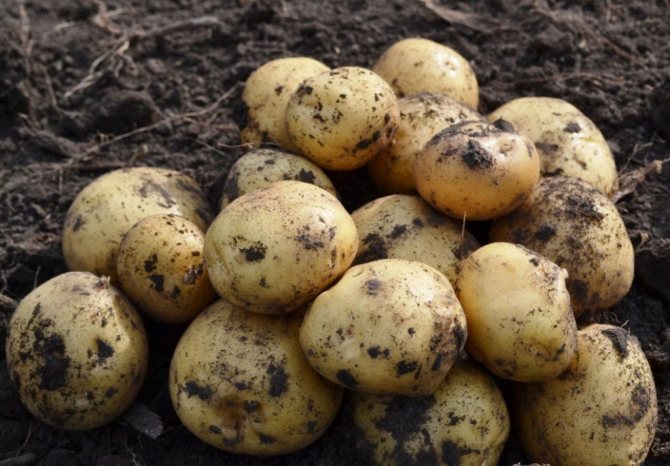

Juvel Potatoes
The soil of potatoes is required fertile, moisture-consuming. Juvel potatoes require a sunny location, as small tubers will form in the shade. Seed Juvel potatoes are germinated for 3-4 weeks, at this time you need to turn the tubers several times for uniform gardening. Seed tubers are pickled to prevent putrefactive diseases.
They can be planted when the soil is moderately warmed up. In the central zone of Russia - these are the last days of April, the first decade of May. The distance in the row spacing is 60-70 cm, between the bushes - 25-30 cm.
The variety is relatively unpretentious, can withstand a short drop in temperature or heat. The main thing is that the Javel potatoes receive all the necessary nutrients and enough liquid. Hilling is carried out twice a season: after mass shoots and during flowering.
To obtain the best yield, it is recommended to feed Jewel potatoes with a complex mineral fertilizer based on potassium or organic fertilizer. As organic matter, bird droppings or mullein solution are suitable. The soil is fertilized before planting and during the second hilling. The variety does not accumulate nitrates.
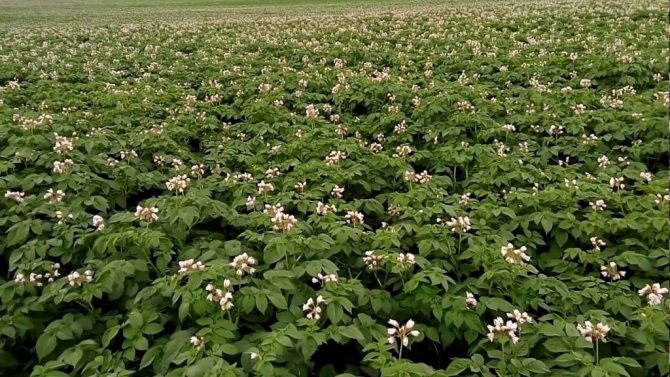

Juvel potatoes in bloom
Watering is required in a timely manner; at low moisture parameters, the tubers grow small. But an excess of water is also undesirable - the product will be watery. An excellent method of irrigation is drip irrigation - it does not erode the fertile layer and impregnates the soil well. After watering, it is advisable to loosen the soil to saturate it with oxygen.
The tops are usually cut before harvesting.The bushes with the best yields can be used as seeds. Tubers selected for planting must be well dried, sorted out and sent for storage. It is enough to buy the seeds of the variety once, and then use your own seed material. According to the creators of the variety, it does not lose its properties in subsequent generations.
When harvesting, you need to carefully dig in the bushes with a pitchfork so as not to damage the tubers. The variety has a delicate skin and is easy to cut with a shovel. You can use a potato digger.
Diseases
Jewel potatoes disease resistance characteristics of the variety:
- cyst nematode - not affected;
- common scab - resistant;
- potato crayfish - protected;
- Alternaria - not affected by early maturation;
- late blight - dangerous with thickened plantings, with re-planting in the second half of summer, with early planting it is not terrible.
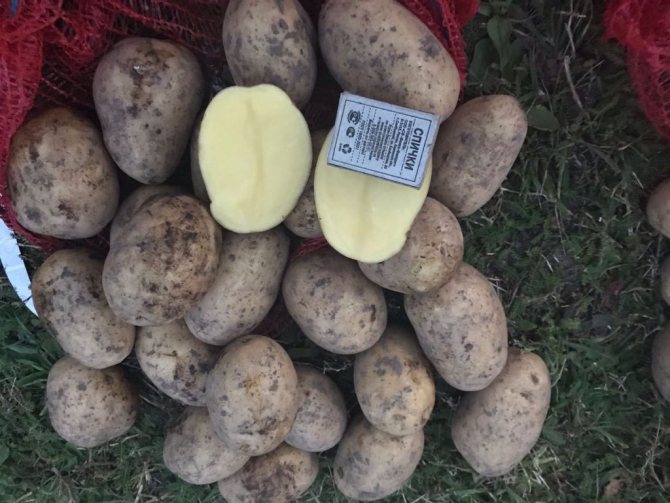

First harvest
To prevent potatoes from being affected by fungal diseases, tubers need to be treated with a disinfectant solution before planting. During growth, spraying with Fitosporin is carried out. The development of diseases is facilitated by a strong thickening of the plantings, therefore, the recommended spacing between the bushes must be observed. Before storing the crop, it is necessary to carefully check the tubers for fungal damage.
Pests
The main pest of not only varietal, but also ordinary potatoes is the Colorado potato beetle. The most common but time consuming way to deal with it is to collect beetles and larvae by hand. Each bush must be carefully examined, the removed parasites are placed in a container with kerosene. You need to repeat the procedure periodically. You can treat a potato field with Tanrek or Corado fungicides. Before planting, to protect against beetle larvae, the tubers are treated with Prestige.
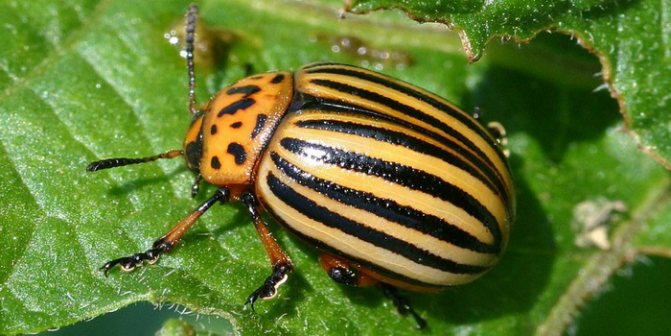

Colorado beetle
To prevent the accumulation of pest larvae and diseases characteristic of potatoes, crop rotation should be used. Also, after harvesting, you can sow the area with legumes, raspberry radish or phacelia.
Advantages and disadvantages of the variety Description of the advantages of the Juvel potato variety:
- High productivity. The tubers are generally medium to large in size, weighing from 80 to 150 grams.
- Ultra-early ripening of the crop. You can start digging young potatoes 50 days after the first shoots.
- A distinctive varietal feature is resistance to most diseases inherent in other varieties of potatoes.
- High resistance to adverse weather conditions: short-term frosts, high air and soil temperatures, short-term drought.
- Tubers are even, smooth, of the same shape, presentation.
- The taste is excellent. Suitable for boiling, frying, mashed potatoes and other types of processing.
- It is stored well, taste is not lost during storage.
The disadvantages of the variety include increased sensitivity to long-term lack or excess of moisture. If Juvel suffers a small drought with small losses in yield, then a prolonged lack of water will lead to the formation of small non-marketable tubers. Therefore, the variety requires watering in the absence of rain.
In general, a German-bred potato variety, the full name of which is Juvel Renata Bettini, is suitable for growing in Russian climatic conditions. In a favorable climate, it allows you to get two harvests of marketable tubers with excellent taste and marketability per season.
To get a rich harvest of potatoes, you should follow the cultivation technology. The first stage in planting a vegetable is the preparation of seed material. To do this, you need to select medium-sized tubers and place them in a place where sunlight hits. This is necessary for the germination of potatoes and the release of a toxic substance in them so that the tuber is not exposed to diseases and pests.
When choosing a site for planting a vegetable, it is advisable to choose a place with direct sunlight, since potatoes are quite demanding on heat and light.
The tubers should be planted in the soil where cucumbers, legumes or cabbage grew last summer. On the contrary, nightshade plants should be avoided, because such vegetables have the same diseases and pests as the Juvel potato variety.
The soil in which the potatoes will be planted is preliminarily recommended to be dug up in the fall and fertilized. In the spring, just before planting, the soil is loosened again, small holes are dug and one potato is placed in them, sprouting upwards. After the hole, they bury it with earth.
Interesting! Although Juvel potatoes are not whimsical in the choice of soil, it is still recommended to plant in black soil, loamy or sandy loam soil.
It is believed that the juvel does not need special care, but in order to obtain a rich harvest, it is necessary to carry out at least minimal care. It should consist in regular watering, hilling bushes, weeding, pest and disease control.
As already mentioned, the size of the tubers depends on the amount of liquid, therefore it is very important to water the potatoes in a timely manner, especially in climates where aridity prevails. In this case, it is advisable to water the wells 2 times a week, but you should not overdo it in order to exclude excess liquid and prevent the plant from rotting.
Hilling should be started when the potatoes are 20 cm high. Since the Juvel variety ripens quickly, 1-2 times of hilling will be enough for the entire time. Thanks to this method, the soil is enriched with oxygen and weeds are weeded.
Also, caring for juvel potatoes is feeding. For this, you can use mineral or organic compounds.
Do not forget about the prevention of pests and diseases. Because despite its resistance to many diseases, the plant can still be affected by rot, late blight, spotting. Therefore, you need to inspect the bushes in time for the presence of insects, and, if necessary, use insecticide preparations for spraying potatoes.
It takes about a month to germinate potatoes. During this time, tubers intended for planting in open soil must be turned over 2-3 times. This will provide better landscaping.
The reason for the low yield is considered to be early or, conversely, late planting. Particular attention should be paid to site selection. Preference should be given to areas with cultivated soil and sufficient lighting. If potatoes are planted in the shade, the tubers will be small.
You can start planting potatoes in late April or early May. It is not at all necessary to wait until the soil is completely warmed up. Its rapid growth is due to its sufficient moisture content. If it is still cold in early May, it is advisable to postpone the planting (no later than 7 days).
Juvel potatoes - description
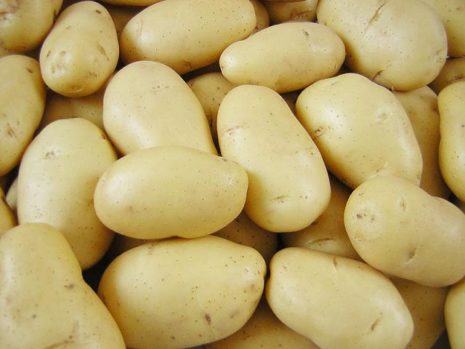

One of the main advantages of this variety is its short stature and compactness, which guarantees economical use of the site with a good harvest.
Characteristic
The shape and size of the stems of this variety are defined as stunted and semi-erect. The leaves of the plant are medium in size, rich in green and characteristic wavy edges. The period of development of potato bushes provides for the appearance of flowers with a red-purple or light lilac color. The stems are of sufficient density and moderate density, which is necessary for the maximum supply of root crops with all the necessary nutrients.
The roots themselves have an oval-rounded shape and a fairly dense yellow peel. The inner flesh is slightly lighter than the peel and has a 10 - 15% starch concentration. Root vegetables are also beneficial for the presence of healthy protein and carotene.The potatoes themselves have a pleasant balanced taste, as well as a medium degree of spreading. The average tuber weight can be about 80 - 150 grams.
Subject to the rules of planting and care, you can count on a harvest of 700 - 800 centners per hectare of land. Another important point concerns the increased immunity of the plant to damage by nematodes and late blight. At least 10 tubers can be harvested from one bush. With the maximum observance of all the rules of processing and care, their number can double.
Origin
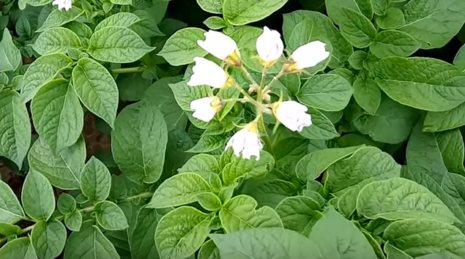

The variety itself was bred by German breeders. Due to its usefulness and yield, the potato variety itself is successfully used both in farm fields and for private cultivation in vegetable gardens. Due to the increased strength of the peel, potatoes retain their freshness and benefits for a long time after digging up, which guarantees their demand for cultivation for the purpose of further sale. The main criteria for the yield of the variety is the degree of soil fertilization, as well as the selected time for planting seed potatoes in open ground.
Yield
The potato variety can be confidently considered a high-yielding variety, since even with average indicators, at least 650 - 900 centners of root crops can be harvested from one hectare of land. When using potatoes in a household, you should expect to get 10 - 16 medium tubers from one bush. The maximum number can be up to 20 tubers.
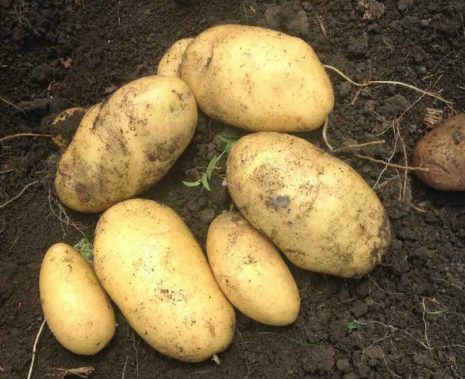

Appearance
The surface of the root crops has a yellow color and characteristic smoothness. The eyes on the peel are small enough. The tubers themselves are distinguished by their rounded oblong shape, as well as the internal fleshiness of the pulp. The weight of the largest tubers can reach 160 - 180 grams. The inside of the potato is light yellow and juicy.
Yield
Gardeners begin planting Juvel potatoes in the last days of March or early April. Ripening will come in May-June. The average yield of potatoes harvested at an early ripening period is about 400 centners per hectare. If Juvel is harvested simultaneously with other, later varieties, its yield will increase to 800 centners per hectare.
The occurrence of late blight is possible with too dense planting or in cases where the grower wants to harvest a second crop. The critical period is from mid-July to late summer.
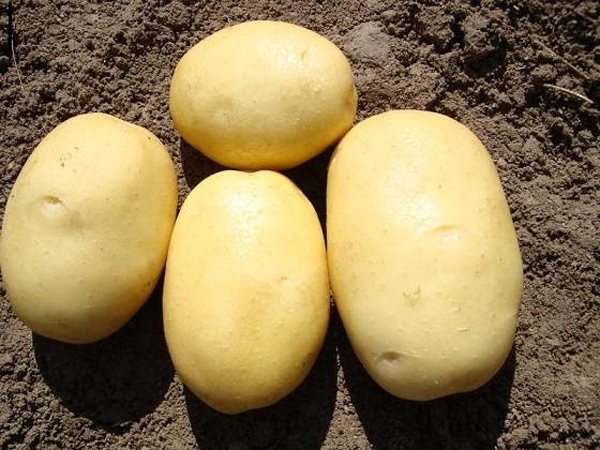

Juvel potatoes were bred by German breeders
The cyst nematode is not terrible for potatoes.
As mentioned above, this variety belongs to the high-yielding variety, since at least 650-900 centners of root crops can be harvested from one hectare of land. The maximum number of tubers from one bush is 20 pieces.
Advantages and disadvantages
The demand for this potato variety among experienced gardeners is due to:
- excellent taste;
- proven high productivity;
- early ripening of potatoes and their successful preservation, which is necessary for sale;
- versatility of use (suitable for preparing first and second courses, does not change taste during heat treatment);
- successful tolerance of the period of drought and short-term frosts;
- the presence of immunity against many common diseases.
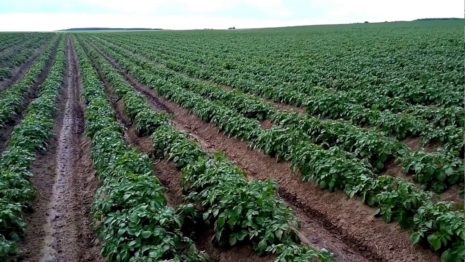

In the list of disadvantages of this potato variety, it is worth indicating an increased sensitivity to insufficient watering: with a constant lack of moisture, tubers grow smaller and their number in a bush is also difficult to call a crop. It should be borne in mind that too frequent rains cause watery potato pulp and loss of its balanced taste.
Growing features
The germination period for potatoes before planting can take about 3 to 4 weeks. At this time, it is recommended to turn the seeds 2 - 3 times for better landscaping. Both too early and late planting can lead to a decrease in potato productivity.For growing this variety of potatoes, it is recommended to choose areas with cultivated soil and good sunlight. A bush growing in the shade will only produce small tubers.
The seeds themselves are recommended to be planted at a distance of 25 - 30 cm from each other. At the same time, there should be about 60 - 70 cm between the rows themselves. This will allow the tubers to receive the necessary nutrients more evenly.
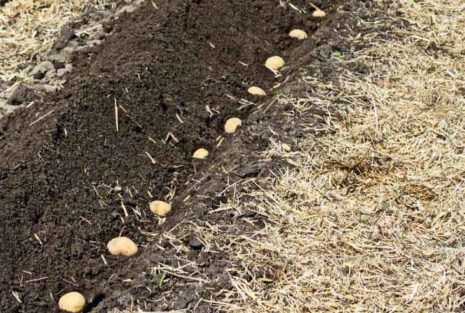

With a good harvest, about 18 - 20 young root crops can grow in one bush. Subject to all the rules, the first crop can be harvested already at the beginning of summer.
It is possible to plant potatoes in an open area without waiting for the soil to warm up sufficiently. As a rule, this happens at the end of April or at the very beginning of May. In this case, rapid growth is also ensured by a sufficient level of soil moisture. If the air temperature is too cold, as for the beginning of May, then the disembarkation process can be postponed a week later, but not more.
It is recommended to hilling potatoes twice: when the first shoots appear and during the flowering period of the bushes. Fertilization with special mineral complexes based on potassium or organic fertilizers is also carried out twice: when planting potatoes and during hilling. Poultry manure or pre-diluted mullein can be used as an organic fertilizer. The first crops can be harvested within 50 days after planting the seeds. To obtain the maximum yield, you need to wait about 18 - 20 days.
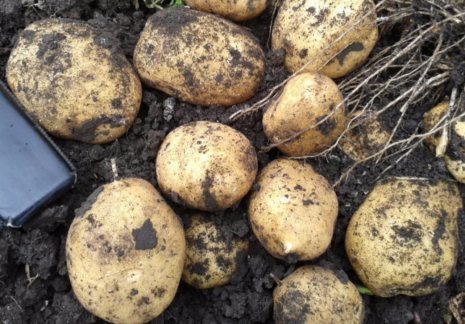

Mandatory requirements for the care of potatoes during the period of their cultivation are limited to maintaining the looseness of the soil and timely harvesting of weeds. An important point is the timely and sufficient hilling of potato rows. It is recommended to loosen the soil after abundant watering of the site, so that oxygen is available to the forming tubers.
How to plant and grow Juwel potatoes
Gardeners wishing to achieve a record harvest carry out a number of manipulations with the seed:
- all sown root crops stored in cellars and other cold and dark places are brought out into the light and in the warmth;
- sort the tubers and remove the spoiled ones;
- the inoculum is disinfected with a boric acid solution (0.2 g of acid per 1 liter of water).
The selection of seed material is carried out during the harvesting process. Before storing seeds in a cellar for long-term storage, they must be "greened" - kept in a well-lit place for a week, remembering to periodically turn them over. This way the tubers are better preserved and protected from rats and mice.
Important! Seeds should be kept separate from tubers.
For planting, tubers are selected, the dimensions of which do not exceed the size of a chicken egg. Seed material is disinfected with a weak solution of potassium permanganate or nitrate. To speed up the development of root crops, potatoes are germinated: they are left warm for three or four weeks. Non-sprouted planting material is discarded.
Juwel is a potato variety that can adapt to any type of soil. As practice shows, the best harvest can be harvested from well-fertilized and moderately moist land.
They begin to prepare the soil in the fall. Winter crops are planted in the beds intended for Juvel potatoes. In the spring, the sprouts of winter crops are removed, and organic fertilizers are applied to the ground. After that, surface loosening of the soil is carried out to a depth of about 30 cm.
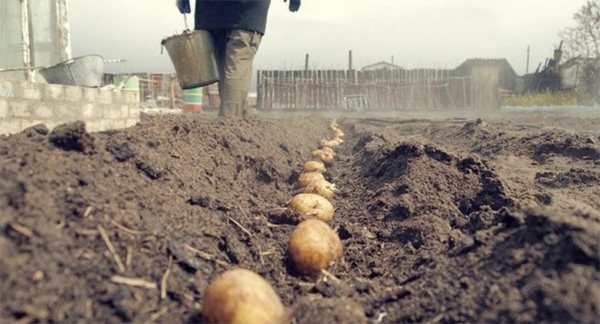

Tubers are planted in mid-April or early May. In the north of Russia, the landing is carried out a few days later. It is possible to plant tubers even if the soil has not warmed up enough, since Juvel is resistant to temperature whims.
If the soil is sandy and light, the potatoes are deepened by 10 cm.When planting in heavy soil, the planting depth should be approximately halved.Experienced vegetable growers, before planting planting material in open ground, dust it with wood ash. It contains large amounts of nitrogen and potassium. Due to the presence of these substances, the plant develops faster.
Note! Experienced gardeners note that when planting Yuvel potatoes in the ground, the acidity of which is higher than the norm, wood ash can be omitted. Sour soil is enriched with chalk and organic fertilizers.
Having finished planting, the ground is leveled and not touched until the first shoots appear.
Planting potatoes can be done in several ways. The lightest are smooth or trench. The most labor-intensive is the smooth planting method. Among gardeners, it has another name - planting under a shovel.
First, holes are dug in the soil, in each of which fertilizers are laid (some vegetable growers use superphosphates). After spreading the potatoes in the holes and pressing them inward, they are poured asleep. If the soil is rich in moisture, the seed may not be watered.
Landing in open ground by a trench method is carried out as follows:
- Furrows are made in the ground, the distance between which is 50–70 cm.
- Juvel potatoes are planted in furrows 20 cm deep and positioned so that the distance between the tubers is 25-30 cm.
Testimonials
I tried this variety for the first time last year. Allocated a couple of rows of the site at the end of April and planted a bucket of seeds there. The rest went under the already traditional potatoes with storage for the winter. The potatoes grew very quickly! About a month later, I watched its flowering, and in June we tried our own young potatoes with dill. The family was happy! Does not require special care, the soil is fertilized annually in the fall. Next year I plan to expand the plot for this variety so that I can eat my young potatoes all summer. By the way, the tubers are not boiled and everything is very tasty.
This potato was recommended by a neighbor. It grows really very quickly, the potatoes themselves are large enough and tasty. It does not require special efforts, occasionally loosened the soil and removed growing weeds. I am thinking about planting this variety not only for my own use, but also for sale. Delicious, easy and fast. Recommend!
Juvel, an ultra-early German potato variety, is suitable for cultivation in all regions of the country. In the southern regions, you can harvest twice if you wish. Compact, low-growing bushes take up little space, guaranteeing economical use of the site. The culture has a strong immunity to most diseases and is highly productive.
In the article we will talk about the rules for growing potatoes, methods of preventing fungal infections, the fight against wireworm larvae, the advantages and disadvantages of the variety.
Diseases and pests
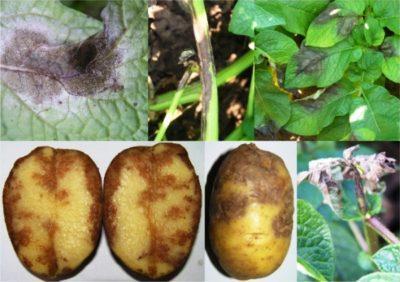

The Juvel variety is well protected from potato crayfish, common scab, cyst nematode. Early ripening protects tubers from late blight and alternaria.
To prevent fungal diseases, it is recommended to till the soil before planting and carefully select all tubers during harvest. By decomposing, they become a breeding ground for harmful microorganisms.
Regular spraying with phytosporin is also saved from the fungus. Do not forget about fungicides when growing.
Potatoes can be threatened by Colorado and click beetles. To protect the plantings, it is recommended to periodically change the fields, during the dormant period treating them with insecticides, herbicides and sowing phacelia, legumes, raspberry radish.
"Juvel" - great choice for early potato lovers... The tubers harvested in the middle of summer are perfectly stored, the seed material does not degenerate. Plants do not require excessive maintenance, making them suitable even for beginners. The variety is suitable for industrial cultivation or personal use.
We also suggest that you familiarize yourself with the varieties of potatoes that have different ripening periods:
| Mid late | Medium early | Early ripe | ||||||
| Melody | Black Prince | Bellarosa | ||||||
| Margarita | Nevsky | Timo | ||||||
| Aladdin | The dark woman | Arosa | ||||||
| Courage | Lord of the open spaces | Spring | ||||||
| Beauty | Ramos | Impala | ||||||
| My lady | Taisiya | Zorachka | ||||||
| Lemon | Bast | Colette | ||||||
| Grenada | Rodrigo | Lyubava | Mozart | Belmondo | Molly | Son | Red Fantasy | Red Scarlett |
The Colorado potato beetle is capable of causing significant damage to potato plantings, which means that information on effective measures to combat it may be useful to you. Read everything about folk remedies and chemicals.
Description of the variety and its origin
The breeding of the Juwel variety was carried out by the breeders of the German company Bavaria-Saat GbR, which unites several seed enterprises. In 2003, the Bavaria-Saat Vertriebs GmbH partnership was founded, whose activities are aimed at selling seeds in Germany and neighboring countries. The vigorous activity of the company contributed to the popularization of this potato variety in the EU countries, the Russian Federation, Belarus and Ukraine.
The variety is still not included in the State Register of Russia, but it is popular in many regions. In the southern regions, it is harvested twice.
The crop is characterized by ultra-early ripening, fast growth and a short growing season. The plant adapts to any climatic conditions and soil quality.
In the photo - Juwel potatoes.
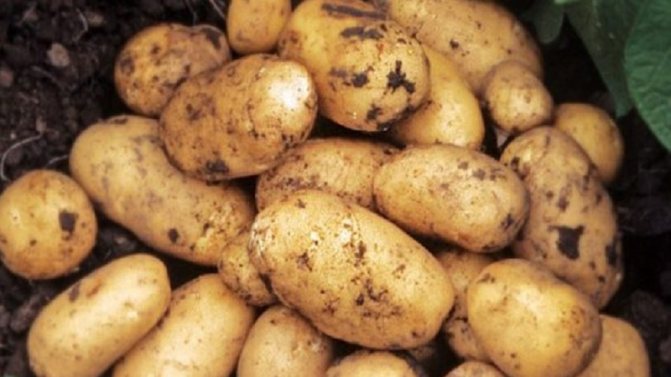

Distinctive features of potatoes are presented in the table.
| Indicators | Characteristic |
| Ripening period | 50-60 days |
| Bush | Low, intermediate type, upright or semi-upright |
| The number of tubers in the bush | 15-20 pcs. |
| Weight | 80-150 g |
| The form | Oval, slightly elongated, with a flat surface without tubercles |
| Coloration | Yellow rind and flesh |
| Leaves | Medium in size, dark green in color, with slight waviness around the edge |
| Corolla color | Purple |
| Starch content | 10-15%. |
| Taste | Middle |
| Cooking class / group | Culinary type B (medium friable) |
| Yield | 450 c / ha at the first digging, 750 c / ha at the next |
| Marketability | 94% |
| Keeping quality | 95% |
| Appointment | Dining room |
| Sustainability | High - to scab, cancer, rotting of tubers, nematode, medium - to late blight of foliage |
| Transportability | High |
Originator
The main originator of the Juvel potato variety is, which unites several enterprises for the development of new potato varieties, but is not the legal patent holder. In 2003 the partnership “Bavaria-Saat Vertriebs GmbH” was founded as part of the company, which, among other things, is engaged in the sale of seed material in Germany and abroad. Thanks to the successful activities of the partnership, Juvel potatoes have become popular in Europe, as well as in Russia, Belarus, Ukraine and many others.
Potato agricultural technology
The cultivation technology of the Juvel variety is standard, and provides for the germination of tubers, timely planting, loosening, weeding, and the introduction of organic and mineral fertilizing.
Timing, scheme and landing rules
Juvel potatoes feel great on any type of soil, subject to the introduction of organic matter and minerals. 20-30 days before planting, the tubers are prepared for germination. Seed potatoes are taken out of the cellar, sorted and disinfected in copper sulfate (1 matchbox of powder, 1 g of potassium permanganate / 10 l of water) or "Fitosporin".
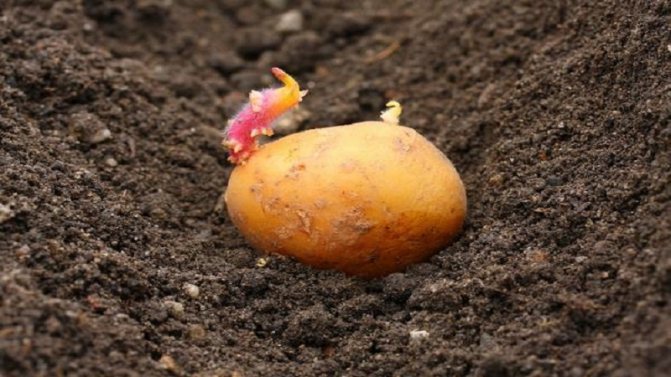

Another way to treat potatoes before sprouting:
- 40 g of urea;
- 60 superphosphate;
- 10 g boric acid;
- 5 g of copper sulfate;
- 1 g of potassium permanganate;
- 10 liters of hot water (80 ° C).
The components are mixed in an enamel bowl and, after cooling, the tubers are soaked in the solution for 15-20 minutes. Then the material is laid out in one layer on a flat surface to dry.
Important! The soil for planting is prepared in the fall: wheat or mustard is dug up and planted. After a month, they are mowed and embedded in the ground. Siderata increase soil nutrition and inhibit the growth of fungi and bacteria.
On the site, holes are formed with a depth of 20 cm with an interval of 25-30 cm.The distance between the rows is 50-70 cm.150-20 g of wood ash is poured into each hole. Small tubers are embedded in the ground entirely, large ones are cut in half and sprinkled with ash.
Planting care rules:
- Watering is carried out as the soil dries out once a week. In hot weather, the frequency of watering is increased up to 2-3 times.
- After moistening, the soil is loosened to prevent the formation of a dense crust and saturation of the root system with air.
- The bushes are spud up as soon as the height reaches 15 cm. Then the manipulation is repeated after flowering. This promotes the formation of more tubers. In parallel, weeding is carried out.
- For feeding, manure and mineral fertilizers with potassium, phosphorus and magnesium are used. The first root portion is applied 30 days before planting (manure or chicken droppings), the second foliar portion - after flowering. To accelerate the formation of tubers, growth stimulants are used - "Epin", "Gibbersib".
Potato grower Juvel recommends applying nitrogen fertilizers in a minimum amount (up to 140 kg / ha). An excess of nitrogen inhibits the development of tubers, impairs taste, and accelerates the growth of tops.
Potash complexes are applied in an amount of 150-300 kg / ha, phosphorus fertilizers - 100 kg / ha. Magnesium fertilization is carried out in an amount of 60-80 kg / ha. The dosage is adjusted depending on the region of growth and the composition of the soil.
Organic dressing options:
- 500 g mullein, 20 urea / 10 liters of warm water;
- 1 tbsp. l. dry chicken manure / 10 l of water.
Mineral dressing options:
- Dissolve 15 g of potassium sulfate with the same amount of double superphosphate in 10 liters of water;
- 100 g superphosphate / 10 l water (use for spraying);
- 50 g of fresh yeast, 50 g of sugar / 10 l of water, leave for 2 hours and add water 1: 5 (solution contains magnesium, zinc, boron, iron);
- 200 g urea, 10 g boric acid / 10 l (spray solution for bushes).
Care
Juvel potatoes are picky about watering, therefore, first of all, we pay attention to this procedure. Typically, potatoes are watered only three times per season. Given the importance of irrigation to Juvel, the number of irrigations is increased to four:
- Once in 15-20 days after sprouting.
- Then, during the beginning of flowering.
- After, in its peak phase.
- And once again before the disappearance of the flowers.
At the same time, we pay attention to the following nuances:
- It is undesirable to water the potatoes before sprouts appear.
- It is not recommended to water the bushes after flowering. This is due to the fact that during this period the tubers ripen, their immunity becomes weaker, and the activity of the late blight fungus is at its peak.
Hilling
Do not forget about hilling. This procedure has a number of functions:
- Helps to form additional stolons. Thanks to them, the yield increases by 20-30%.
- Loosens the soil, saturating it with oxygen. Oxygen is an important component in the development of culture.
- Cleans the area of weeds.
Juvel is huddled 2 times per season. The first time, when the tops become 18-20 cm, the second - 3 weeks after the first procedure.
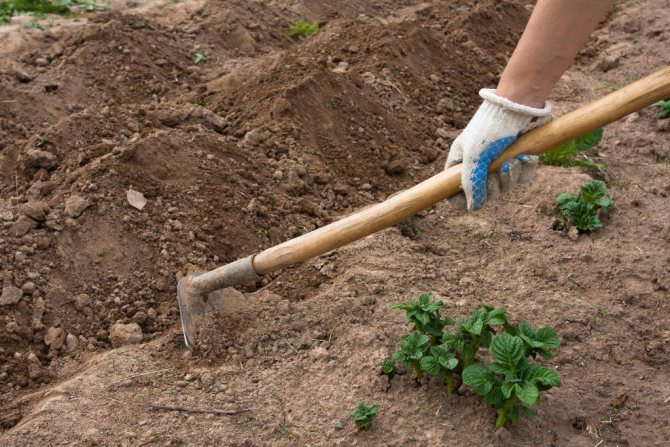

Collection, storage and use of the crop
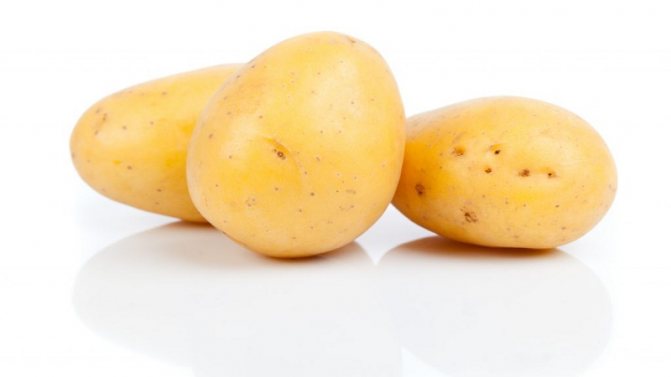

The first harvest is dug up in the last decade of June when the tubers are planted early (in April-early May). When planted late, potatoes ripen 1-2 months later. Harvesting in June allows you to make up for the shortage of products in the off-season.
The peculiarity of the variety lies in the loss of taste and presentation during long storage. This is due to the early ripening period. A high-quality harvest can be kept in the cellar until November.
Before digging the potatoes, the dry tops are mowed and burned. Harvesting is carried out in dry sunny weather, sorted and dried in a dark room for 3-4 days. Then the tubers are laid out in boxes or bags and stored in a cool room.
Reference. Potatoes are best kept with beets, which are placed on top. Root vegetables absorb excess moisture and prevent rotting.
On a balcony or loggia, potatoes are stored in homemade double boxes, inserted into each other according to the principle of matryoshka dolls. The space is filled with foam or dry sawdust. Tubers are periodically sorted out, spoiled and green ones are thrown away.
Potatoes are suitable for boiling, baking, frying, making soups. During heat treatment, it retains its structure, does not fall apart.
Due to their low starch content, the tubers are not suitable for mashed potatoes, but a crispy crust forms on the surface when fried or baked.
Storage
Juvel variety is not suitable for long-term winter storage. It is mainly grown commercially in early summer. The demand for it is huge, due to its excellent taste and useful substances that are present in it.
For whatever purpose you would not plan to grow this variety (for sale or for yourself), you need to take into account all the subtleties of this matter. If you follow all the recommendations, you can harvest a rich harvest.
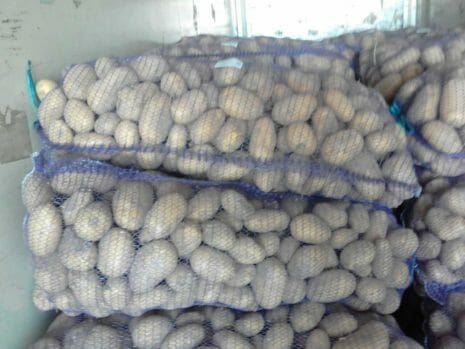

Advantages and disadvantages of the variety
Advantages:
- early maturity;
- high productivity;
- the opportunity to get two crops when cultivated in the southern regions of the country;
- attractive appearance;
- the possibility of transportation over long distances;
- disease resistance;
- drought resistance;
- undemanding to the composition of the soil;
- if damaged, the wounds heal quickly.
Disadvantages:
- average taste;
- watery structure and insipid taste with an excess of moisture;
- short shelf life.
Farmers reviews
Reviews of the Juwel variety are mostly positive. The crop attracts the attention of farmers with its early ripening period, high productivity and resistance to most diseases.
Lyudmila, Cheremisinovo: “I have been growing potatoes for three years in a row. The bushes bloom in a beautiful purple color. I plant early and harvest twice - in June and September. This is an excellent early variety that is not afraid of drought, Colorado potato beetle and late blight. Young potatoes with dill and butter are especially tasty. "
Larisa, Kantemirovka: “I grow Juvel for my own needs in order to get early potatoes. I start planting in April, by which time the land in our region has time to warm up a little. I dig it in mid-June. Not suitable for long-term storage. I water the bushes moderately so that the tubers are not too watery. I feed it with manure before planting, and then once with superphosphate. "
Andrey, Salsk: “I first tried to plant this variety the year before last. I liked the result, so I decided to start growing potatoes for sale. The taste is good, it is important not to overflow the bushes, otherwise the tubers will be watery and fresh. The early maturity of the crop allows harvesting in June. The plant is unpretentious in care, responds well to mineral fertilizing. "

